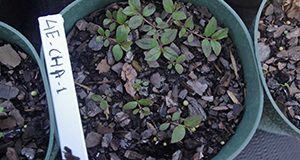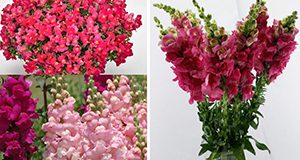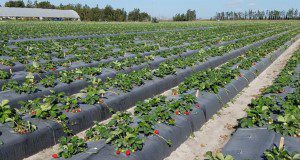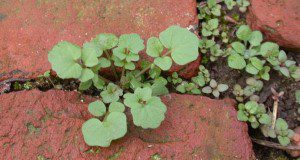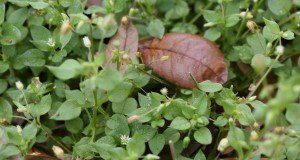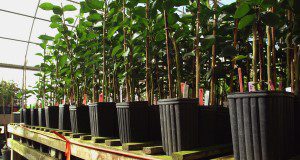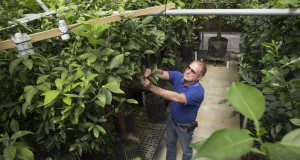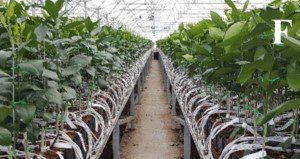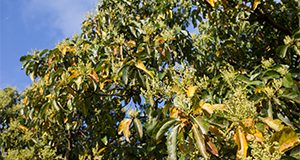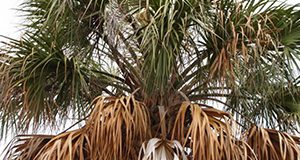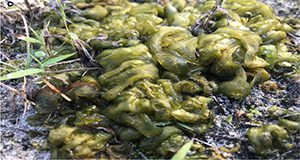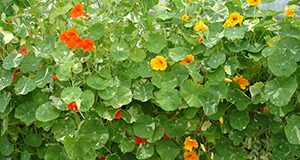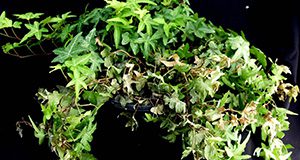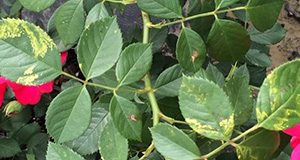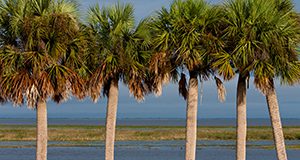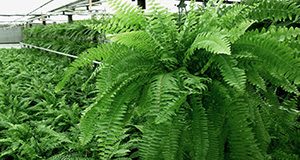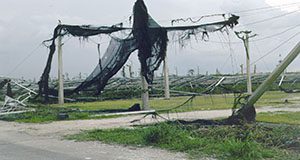The purpose of this report is to summarize ornamental plant producers' perceptions about neonicotinoid labeling and anticipated changes in production practices due to neonicotinoids labeling policy intervention. The target audience is industry, state agency, and public stakeholders involved in decisions and policy making related to the use of neonicotinoid insecticides in the U.S. ornamental plants industry.
https://edis.ifas.ufl.edu/fe1094
Category: Nursery & Greenhouse
Biology and Management of Garden Spurge (Euphorbia hirta) in Ornamental Crop Production
Garden spurge is a prostrate, herbaceous, short-lived, warm-season annual weed commonly found in Florida landscapes, container nurseries, and other agricultural production areas. This 5-page article is written to aid green industry professionals and others in the identification and management of garden spurge in and around ornamental plants. Written by Thomas Smith, Chris Marble, Shawn Steed, and Nathan Boyd, and published by the UF/IFAS Environmental Horticulture Department, July 2020.
https://edis.ifas.ufl.edu/ep586
Development of a Model Mutagenesis System for Snapdragon
This 4-page document describes the advantages of snapdragon’s elegant transposon mutagenesis system and its connection to plant breeding. Written by Zhaoyuan Lian, Heqiang Huo, Sandra Wilson, and Jianjun Chen, and published by the UF/IFAS Environmental Horticulture Department, August 2020.
https://edis.ifas.ufl.edu/ep584
The UF/IFAS Strawberry Clean Plant Program
Florida strawberry growers primarily utilize cultivars developed by the UF/IFAS Strawberry Breeding Program. These cultivars are bred to provide the yield and quality traits needed by the Florida industry. Yet if a new cultivar has the traits that Florida growers need but pathogen-tested planting stock is not available to growers, the cultivar’s impact will be limited. The Clean Plant Program generates the pathogen-tested planting stock that nurseries and growers require. This new 5-page publication of the UF/IFAS Horticultural Sciences Department, written by Catalina Moyer, Natalia A. Peres, and Vance M. Whitaker, is intended to educate both the industry and the public on the importance of the Clean Plant Program and the methods used to produce planting stock of new cultivars.
https://edis.ifas.ufl.edu/hs1343
Stock Plant and Tree Production: Weed Management in Citrus Nurseries
All citrus nursery stock in Florida is raised in enclosed greenhouses. It is not uncommon for weeds to grow in containers, where they compete with citrus seedlings, and on greenhouse floors, where they can harbor pests and diseases. This new 7-page publication of the UF/IFAS Horticultural Sciences Department provides descriptions of a few commonly found weeds in citrus nurseries and good weed management practices. Written by Biwek Gairhe, Ramdas Kanissery, and Brent Sellers, this article is chapter 8c of the forthcoming Citrus Nursery Production Guide.
https://edis.ifas.ufl.edu/hs1344
Biology and Management of Common Chickweed (Stellaria media) in Ornamental Crop Production
Chickweed is a common cool-season annual weed in Florida landscapes, container nurseries, home gardens, and other agricultural production systems. This new 5-page article is written for green industry professionals and others to aid in the identification and management of chickweed in and around ornamental plants. Written by Yuvraj Khamare, Chris Marble, Nathan Boyd, and Shawn Steed and published by the UF/IFAS Environmental Horticulture Department.
https://edis.ifas.ufl.edu/ep577
Rootstock Selection
The large number of different rootstock varieties currently available for citrus production in Florida is unprecedented. This new 4-page article, chapter 4 of the forthcoming UF/IFAS Citrus Nursery Production Guide, provides information on rootstock uses in Florida, rootstock propagation, and the impact of tissue culture, as well as factors to consider when deciding which rootstock to plant. Written by Ute Albrecht, Manjul Dutt, and Jude Grosser and published by the UF/IFAS Horticultural Sciences Department.
https://edis.ifas.ufl.edu/hs1340
Seed and Budwood Production, Transport, and Conservation
The Florida citrus industry maintains a high demand for trees for replanting and resetting, as well as an interest in new releases of rootstocks and scions with improved disease and abiotic stress tolerances. One of the main constraints for liner production in great numbers is time. The consensus among citrus nurseries is that it takes two years to produce enough quantities of budwood to establish seed block trees when a new interesting rootstock is produced. This new 3-page article addresses the practices and challenges of producing seeds and budwood in Florida. This article, chapter 7 of the forthcoming Citrus Nursery Production Guide, was written by Fernando Alferez and Mireia Bordas and is a publication of the UF/IFAS Horticultural Sciences Department.
https://edis.ifas.ufl.edu/hs1336
Stock Plant and Tree Production: Irrigation and Fertilization
Citrus tree production in nurseries can be divided into three stages: production of rootstock liners, transplant of rootstocks into larger containers, and bud grafting. The objectives of this new 6-page publication of the UF/IFAS Horticultural Sciences Department are to provide general information on irrigation and fertilization for production of citrus nursery trees in seedbeds, nurseries and budwood multiplication blocks. This article, written by Rhuanito Soranz Ferrarezi, is chapter 8b of the forthcoming Citrus Nursery Production Guide.
https://edis.ifas.ufl.edu/hs1333
The Value of Tropical Plant Diversity
This new 5-page document discusses plant diversity at the UF/IFAS Tropical Research and Education Center, environmental factors and human activities affecting these plants, assemblages of species based on levels of disturbance, human choice, and other factors, and the diverse needs these plants meet. Written by Cliff G. Martin and Zachary T. Brym, and published by the UF/IFAS Agronomy Department, June 2019.
http://edis.ifas.ufl.edu/ag435
Lethal Bronzing Disease (LBD)
Lethal bronzing disease (LBD), formerly Texas Phoenix Palm Decline (TPPD), is a lethal phytoplasma infection of various palm species in the state of Florida. It was first detected in Florida in 2006 and has since spread to 31 different counties and been isolated from 16 different species of palm. This three-page fact sheet describes the pathogen and hosts of LBD, its symptoms, how to diagnose it, and disease management practices. Written by Brian W. Bahder and Ericka Helmick and published by the UF/IFAS Plant Pathology Department, this article is a revision of an earlier fact sheet by Nigel A. Harrison and Monica L. Elliott.
https://edis.ifas.ufl.edu/pp163
Biologia y Manejo de Nostoc (Cyanobacteria) en Viveros y Invernadores
Este artículo es escrito para ayudar el lector a entender la biología y ecología de Nostoc, un género común de cianobacteria (alga verdeazulada) de suelos húmidos, y proporcionar métodos para manejar esta plaga en viveros. This 4-page document is the Spanish version of Biology and Management of Nostoc (Cyanobacteria) in Nurseries and Greenhouses. Written by H. Dail Laughinghouse IV, David E. Berthold, Chris Marble, and Debalina Saha, and published by the UF/IFAS Agronomy Department, April 2019.
http://edis.ifas.ufl.edu/ag432
Biology and Management of Nostoc (Cyanobacteria) in Nurseries and Greenhouses
This new 4-page document provides an overview of the biology and ecology of Nostoc-like cyanobacteria (blue-green algae) in humid soils and discusses cultural, physical, and chemical methods to manage this weed in nursery environments. Written by H. Dail Laughinghouse IV, David E. Berthold, Chris Marble, and Debalina Saha, and published by the UF/IFAS Agronomy Department, February 2019.
http://edis.ifas.ufl.edu/ag430
Production of Edible Flowers in Florida
Edible flowers can be a fresh addition to main dishes, side dishes, desserts, and drinks. Their value stems from their visual appeal, taste, nutritional content, and medicinal properties. This 7-page document examines the production and distribution of edible flowers in Florida. Written by Caroline de Favari Tardivo and Geoffrey Meru and published by the UF/IFAS Horticultural Sciences Department, August 2018.
http://edis.ifas.ufl.edu/hs1321
English Ivy (Hedera helix): Identification and Control of Diseases in Commercial Greenhouse Production and in Landscapes
English ivy has grown in popularity over the last few years as both an indoor and outdoor ornamental vining plant. While English ivy is very disease resistant, there are a few major diseases that will cause economic loss in production and landscape plantings. This 6-page document will assist residential or commercial property owners in identifying various English ivy diseases. Written by David J. Norman and G. Shad Ali and published by the UF/IFAS Plant Pathology Department, August 2018.
http://edis.ifas.ufl.edu/pp339
Rose Mosaic Virus: A Disease Caused by a Virus Complex and Symptoms on Roses and Management Practices
Rose mosaic virus disease is one of the most economically important diseases affecting roses, because a single symptomatic leaf can result in the rejection of complete shipments for wholesale or retail rose producers. It continues to be a problem in nursery production and landscapes. This 5-page document discusses the causes, symptoms, and management of this disease. Written by Susannah da Silva, Binoy Babu, Mathews L. Paret, Gary Knox, Fanny Iriarte, Barron Riddle, Matt Orwat, Shawn T. Steed, E. Vanessa Campoverde, and Svetlana Y. Folimonova and published by the UF/IFAS Plant Pathology Department, August 2018.
http://edis.ifas.ufl.edu/pp338
Sampling Palms for Lethal Yellowing and Texas Phoenix Palm Decline Phytoplasmas
In Florida, palms are an economically important group of trees in the nursery and landscaping industries. Phytoplasma diseases of palms are a major concern because they infect a wide variety of these valuable ornamental palms, and they are lethal. Once symptoms appear, trees begin to decline, frequently rapidly, and can die in as few as 3 to 5 months. This 4-page fact sheet written by Brian W. Bahder and Ericka E. Helmick and published by the UF/IFAS Department of Entomology and Nematology describes how to sample palms for disease and how to submit samples to the Vector Entomology Lab. Includes a table listing equipment and supplies and protocol for sampling palm trunk tissue.
http://edis.ifas.ufl.edu/in1197
Cultural Guidelines for Commercial Production of Boston Fern (Nephrolepsis exaltata ‘Bostoniensis’)
‘Bostoniensis’, or Boston fern, is a popular sword fern variety that is one of the most important foliage crops in the ornamental plant industry. This 5-page article describes common Boston fern cultivars, provides guidelines for their culture and interior use, and lists physiological problems that may be encountered during production and interiorscape use. Written by Bill Schall, Heqiang Huo, and Jianjun Chen and published by the UF/IFAS Department of Environmental Horticulture, January 2018.
http://edis.ifas.ufl.edu/ep550
Hurricane Preparation List for the Container Nursery
Busy professionals don’t often have time to consider the impact a hurricane can have on their nursery until one is on the way. This 2-page fact sheet provides a list of items and tasks to complete prior to a hurricane’s arrival to minimize damage to the nursery. Written by Tom Yeager and published by the UF/IFAS Environmental Horticulture Department, December 2017.
http://edis.ifas.ufl.edu/ep547
Caladium Cultivars 'Cosmic Delight', 'Fiesta', and 'Hearts Desire'
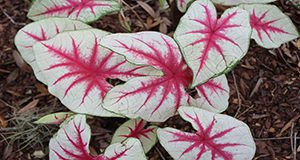 Caladiums are commonly grown in containers, hanging baskets, or planted directly in the landscape as accent and border plants. New caladium cultivar introductions are important to the Florida caladium industry, the greenhouse/nursery industries, and commercial landscape maintenance companies. The UF/IFAS Gulf Coast Research and Education Center released three new caladium cultivars, ‘Cosmic Delight’, ‘Fiesta’, and ‘Hearts Desire’, in 2015. This 7-page document describes the characteristics, production potential, and performance of these cultivars. Written by Zhanao Deng and published by the UF/IFAS Environmental Horticulture Department, December 2017.
Caladiums are commonly grown in containers, hanging baskets, or planted directly in the landscape as accent and border plants. New caladium cultivar introductions are important to the Florida caladium industry, the greenhouse/nursery industries, and commercial landscape maintenance companies. The UF/IFAS Gulf Coast Research and Education Center released three new caladium cultivars, ‘Cosmic Delight’, ‘Fiesta’, and ‘Hearts Desire’, in 2015. This 7-page document describes the characteristics, production potential, and performance of these cultivars. Written by Zhanao Deng and published by the UF/IFAS Environmental Horticulture Department, December 2017.
http://edis.ifas.ufl.edu/ep545
